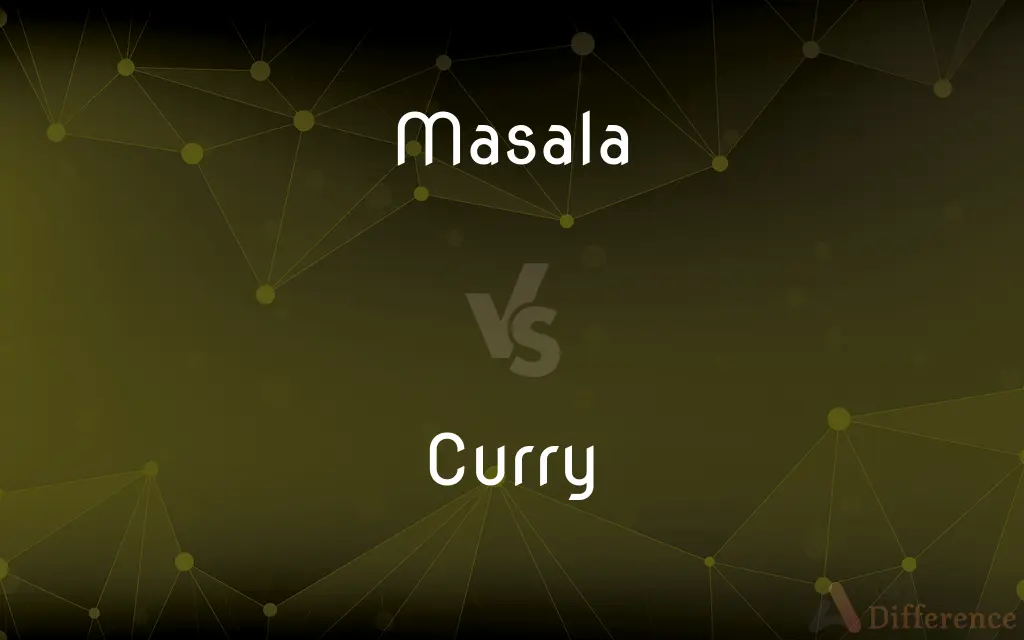Masala vs. Curry — What's the Difference?
By Tayyaba Rehman & Maham Liaqat — Updated on April 16, 2024
Masala refers to a blend of spices ground into a powder or paste, used in Indian cooking; curry typically denotes a dish flavored with various spices, often including a masala.

Difference Between Masala and Curry
Table of Contents
ADVERTISEMENT
Key Differences
Masala is a term used in Indian cuisine to describe a specific blend of ground spices that may include turmeric, cumin, coriander, and many others, designed to impart a rich flavor and aroma. In contrast, curry refers more broadly to any dish in various global cuisines that is seasoned with a complex combination of spices and herbs, often including a masala as a base.
In preparation, masalas can be dry or wet. Dry masalas are simply mixed powdered spices, while wet masalas are made by combining spices with water, vinegar, or other liquids to form a paste. On the other hand, curry dishes can vary widely, encompassing everything from thick, stew-like preparations to thinner, soup-like consistencies, depending on the region and recipe.
The use of masala is not limited to curries; it can be used as a seasoning for various types of dishes, including marinades and dry rubs. Conversely, curry is a dish in itself, often served with rice or bread like naan or roti.
Masala mixes are often made fresh and used immediately in dishes to maximize their flavor, or they can be stored for later use. However, curry dishes are usually prepared by cooking meat, vegetables, or legumes with a masala and additional ingredients like coconut milk or tomatoes to create a harmonious blend of flavors.
While masala directly influences the flavor profile of a dish by the specific blend of spices chosen, curry dishes can vary widely in taste, heat, and texture, influenced by local ingredients, cultural preferences, and individual cooking techniques.
ADVERTISEMENT
Comparison Chart
Definition
Blend of ground spices
Dish flavored with spices and herbs
Consistency
Can be dry powder or wet paste
Typically a cooked, saucy dish
Use
Seasoning for various dishes
Complete dish usually served with sides
Preparation
Mixed as needed, used fresh or stored
Cooked with ingredients like meats, veggies
Variability
Specific to spice blend
Wide variations depending on region
Compare with Definitions
Masala
Spice blend.
Garam masala is a popular spice blend in North Indian cooking.
Curry
Stew-like preparation.
A lamb curry often includes a thick, spicy sauce.
Masala
Seasoning mix.
Tandoori masala is used primarily to marinate chicken for tandoori cooking.
Curry
Varied recipes.
Thai green curry uses green chilies and basil for its unique flavor.
Masala
Aromatic spices.
Masala for chai includes cinnamon, cardamom, and cloves.
Curry
Spicy dish.
Chicken curry is made with a mix of spices and coconut milk.
Masala
Wet paste.
A masala paste can include garlic, ginger, and onions ground together.
Curry
Vegetarian options.
Chickpea curry is a popular vegetarian dish in many countries.
Masala
Dry mixture.
Chaat masala is sprinkled on snacks to enhance flavor.
Curry
Served with rice.
Curry is traditionally served over basmati rice to soak up the flavorful sauce.
Masala
Any of various mixtures of spices that are used in South Asian cuisine.
Curry
Curry is a variety of dishes originating in the Indian subcontinent. It uses a combination of spices or herbs, usually including ground turmeric, cumin, coriander, ginger, and fresh or dried chilies.
Masala
Any of many blends of spices used in Indian cuisine, most often containing cardamom, coriander, mace together with pepper, nutmeg, fennel seeds, jeera etc.
Curry
To groom (a horse) with a currycomb.
Masala
Any dish prepared with such spices.
We ordered two lamb bhunas and a masala.
Curry
To prepare (tanned hides) for use, as by soaking or coloring.
Curry
To season (food) with curry.
Curry
A dish of meat or vegetables flavored with pungent spices, typical of South Asian and Southeast Asian cuisines.
Curry
A blend of spices used in or suggesting the flavor of curry, typically containing turmeric, cumin, coriander, and ginger, among other ingredients.
Curry
Curry powder.
Curry
One of a family of dishes originating from Indian cuisine, flavoured by a spiced sauce.
Curry
A spiced sauce or relish, especially one flavoured with curry powder.
Curry
Curry powder.
Curry
(transitive) To cook or season with curry powder.
Curry
(transitive) To groom (a horse); to dress or rub down a horse with a curry comb.
Curry
(transitive) To dress (leather) after it is tanned by beating, rubbing, scraping and colouring.
Curry
(transitive) To beat, thrash; to drub.
Curry
(transitive) To try to win or gain (favour) by flattering.
Curry
To perform currying upon.
Curry
To scurry; to ride or run hastily
Curry
To cover (a distance); (of a projectile) to traverse (its range).
Curry
To hurry.
Curry
To dress or prepare for use by a process of scraping, cleansing, beating, smoothing, and coloring; - said of leather.
Curry
To dress the hair or coat of (a horse, ox, or the like) with a currycomb and brush; to comb, as a horse, in order to make clean.
Your short horse is soon curried.
Curry
To beat or bruise; to drub; - said of persons.
I have seen him curry a fellow's carcass handsomely.
Curry
To flavor or cook with curry.
Curry
A kind of sauce much used in India, containing garlic, pepper, ginger, and other strong spices.
Curry
A stew of fowl, fish, or game, cooked with curry.
Curry
(East Indian cookery) a pungent dish of vegetables or meats flavored with curry powder and usually eaten with rice
Curry
Season with a mixture of spices; typical of Indian cooking
Curry
Treat by incorporating fat;
Curry tanned leather
Curry
Give a neat appearance to;
Groom the dogs
Dress the horses
Common Curiosities
What is masala used for in cooking?
Masala is used as a spice blend to season and add flavor to dishes.
What’s the difference between curry powder and garam masala?
Curry powder is generally a mix used specifically for creating curries, while garam masala is a blend used in various Indian dishes.
Are all curries hot and spicy?
Not all curries are hot; the spice level can vary greatly depending on the type of spices used.
Is masala always spicy?
Masala isn't necessarily spicy hot; it can range from mild to very spicy depending on the spices used in the blend.
Can I make my own curry masala at home?
Yes, you can make your own curry masala by mixing specific ground spices according to your taste preferences.
What are some common spices in a typical masala?
Common spices in masala might include cumin, coriander, turmeric, pepper, and cardamom.
What defines a dish as a curry?
A dish is typically called a curry if it has a spiced sauce and is part of Indian or other South Asian cuisines.
Can curry be made without coconut milk?
Yes, there are many recipes for curry that do not use coconut milk.
Is there a difference between restaurant-style and homemade curries?
Restaurant-style curries are often richer and creamier due to higher use of cooking fats and creams, whereas homemade curries might be lighter and adjusted to personal health preferences.
Can I substitute curry powder for masala in recipes?
While you can substitute curry powder for masala, the flavor profile will change since curry powder blends differ from traditional masalas.
Are masalas used outside of Indian cuisine?
Yes, masalas are also used in other cuisines such as Middle Eastern and Southeast Asian, though they may be adapted to fit local tastes.
How do regional differences affect curry recipes?
Regional differences can significantly influence the ingredients and cooking methods used in curry recipes, resulting in diverse flavors and textures across different areas.
What is the best way to enhance the flavor of a masala?
Roasting the spices before grinding them can greatly enhance the flavor and aroma of a masala.
How long can I store homemade masala?
Homemade dry masala can be stored in an airtight container in a cool, dark place for up to 6 months, while wet masala should be used within a few days or frozen for longer storage.
What makes a curry yellow, red, or green?
The color of a curry depends on the spices and ingredients used: turmeric gives a yellow color, red chilies or tomatoes give a red color, and green chilies and herbs like cilantro result in a green curry.
Share Your Discovery

Previous Comparison
Coach vs. Wagon
Next Comparison
Arab vs. BerberAuthor Spotlight
Written by
Tayyaba RehmanTayyaba Rehman is a distinguished writer, currently serving as a primary contributor to askdifference.com. As a researcher in semantics and etymology, Tayyaba's passion for the complexity of languages and their distinctions has found a perfect home on the platform. Tayyaba delves into the intricacies of language, distinguishing between commonly confused words and phrases, thereby providing clarity for readers worldwide.
Co-written by
Maham Liaqat















































